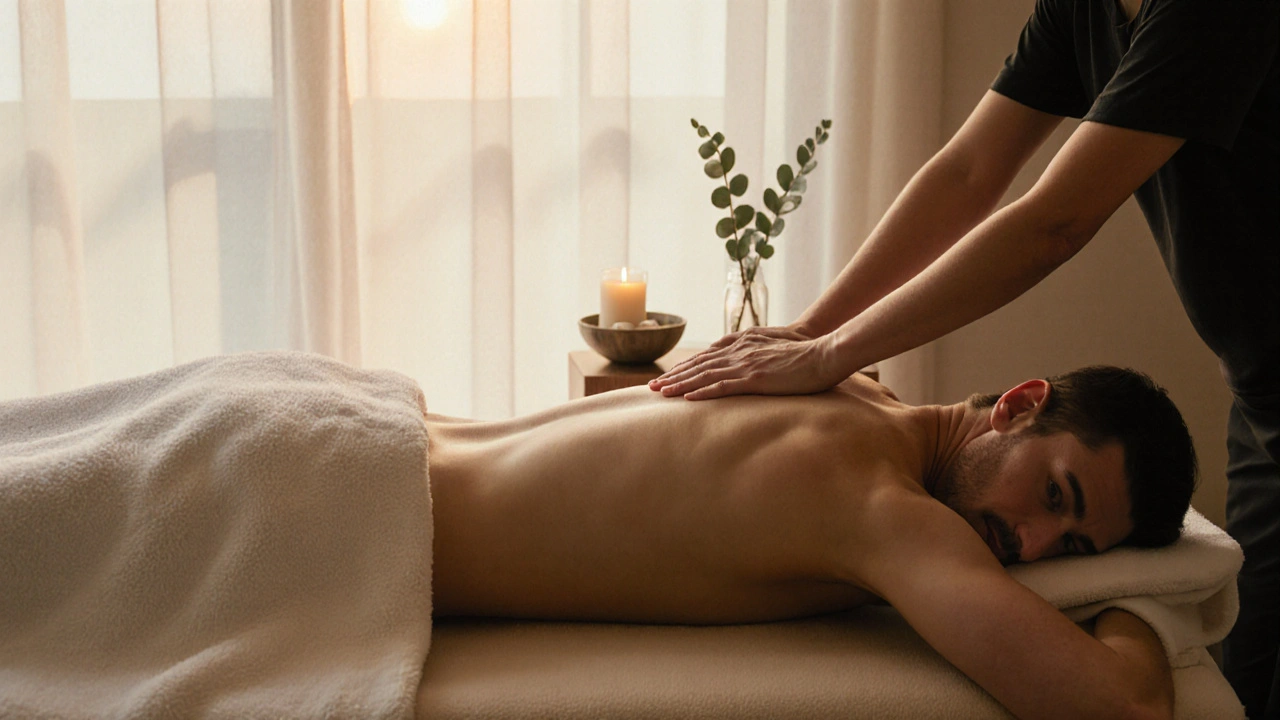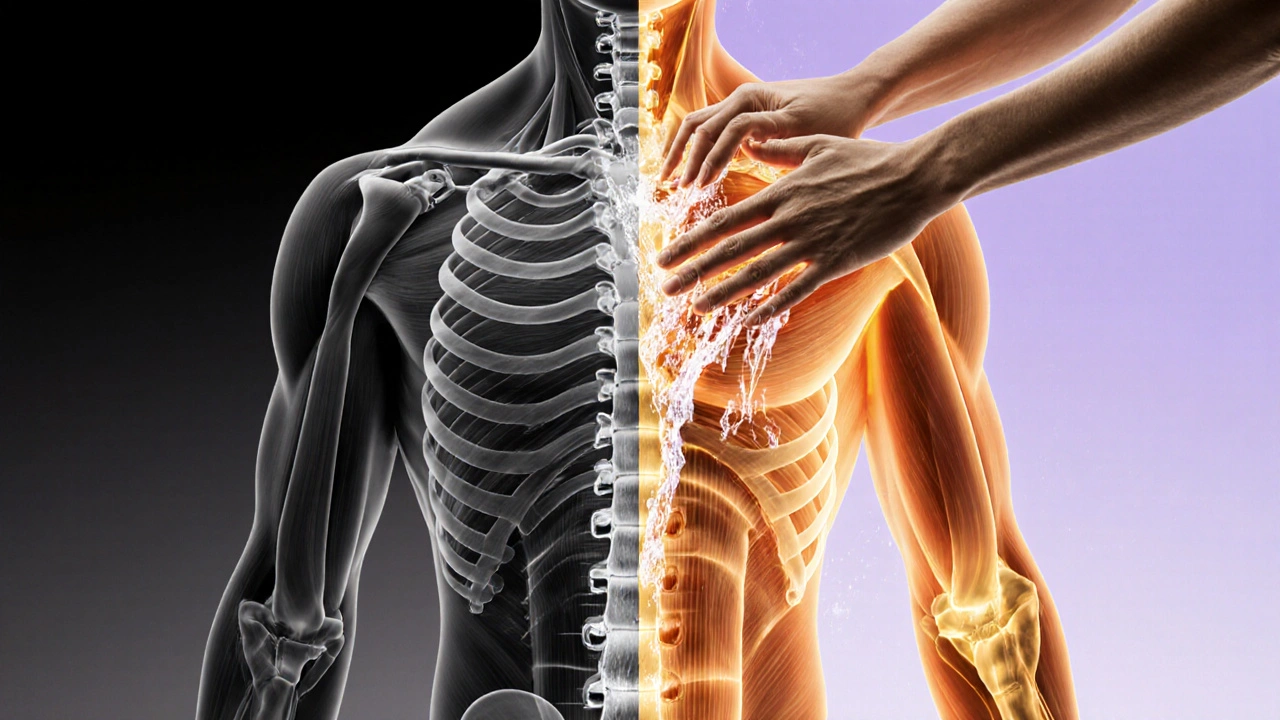Full Body Massage: A Comprehensive Guide for Beginners

You’ve probably seen people leaving a spa with that quiet, glowing look-like they just shed a heavy coat they didn’t even know they were wearing. That’s what a full body massage does. It’s not just about feeling good for an hour. It’s about resetting your nervous system, loosening muscles that have been tight for months, and giving your mind a real break. If you’ve never tried one, you might think it’s expensive, awkward, or just for people who already know what they’re doing. But here’s the truth: full body massage is one of the most accessible forms of self-care you can try-even if you’ve never stepped into a spa before.
What Exactly Is a Full Body Massage?
A full body massage isn’t just a fancy term for "they rubbed my back." It’s a structured session that covers your back, neck, shoulders, arms, hands, legs, feet, and sometimes even your head and face. Most therapists work from head to toe in a single session, usually lasting 60 to 90 minutes. You’ll lie on a warm table, covered with a sheet or towel, and only the part being worked on will be uncovered at any time. It’s not about being naked-it’s about being comfortable.
The goal? To release tension, improve circulation, and help your body recover from daily stress. Unlike targeted massages like foot or head therapy, a full body session treats you as a whole system. That’s why people often say they feel "lighter" afterward-not just physically, but mentally too.
Why Try a Full Body Massage? Real Benefits, Not Just Hype
Let’s cut through the spa marketing. What does a full body massage actually do for you?
- Reduces muscle stiffness: If you sit at a desk all day, your shoulders, lower back, and hips get locked up. A massage helps loosen those knots without needing a chiropractor.
- Lowers stress hormones: A 2022 study from the University of Miami found that after one full body massage, cortisol levels dropped by an average of 31%. That’s like taking a vacation without leaving town.
- Improves sleep: If you’ve ever laid awake because your body felt "on," a massage helps your nervous system switch from "fight or flight" to "rest and digest."
- Boosts circulation: Better blood flow means more oxygen to your muscles and faster recovery after workouts or long days.
- Helps with headaches: Tension headaches? Often caused by tight neck and shoulder muscles. A massage targets those areas directly.
One client told me, "I didn’t realize how much my shoulders hurt until they didn’t anymore." That’s the magic. You don’t notice the pain until it’s gone.
What Types of Full Body Massage Are There?
Not all full body massages are the same. The technique used changes the experience-and what you get out of it.
- Swedish massage: The most common type. Gentle, flowing strokes. Perfect for beginners. Think relaxation, not deep pressure.
- Deep tissue massage: Targets deeper layers of muscle and connective tissue. Better if you’re an athlete or carry chronic tension. Can feel intense, but not painful.
- Hot stone massage: Smooth, heated stones are placed on key points and used to massage. The warmth melts tension in a way hands alone can’t.
- Thai massage: Done on a mat, not a table. You wear loose clothes. The therapist uses their hands, knees, and feet to stretch and press. More active than traditional massage.
- Shiatsu: Based on acupressure. Focused pressure along energy lines. Often includes gentle stretching.
For beginners, start with Swedish. It’s the gateway. If you like it, you can explore deeper options later.
What Happens During Your First Session?
First-time clients often worry about what to expect. Here’s the real step-by-step:
- You’ll fill out a short form-medical history, areas of pain, preferences (pressure level, areas to avoid).
- You’ll be shown to a private room. The therapist will leave so you can undress to your comfort level. Most people keep their underwear on.
- You lie on the table, covered with a towel. The therapist knocks before entering.
- They’ll start with your back. If you’re uncomfortable at any point, say something. Good therapists welcome feedback.
- You’ll be asked to flip over halfway through. That’s when your legs, arms, and feet get worked on.
- Afterward, you’ll have time to get dressed. The therapist might offer water or ask if you want to sit for a few minutes.
Don’t worry about being "good" at it. You don’t need to relax on command. Just breathe. Let your body sink into the table. That’s all it takes.

How Much Does a Full Body Massage Cost?
Prices vary by location, therapist experience, and session length. In most cities, here’s what you’ll pay:
| Session Length | Price Range | Best For |
|---|---|---|
| 60 minutes | $60-$100 | First-timers, maintenance |
| 75 minutes | $80-$130 | More time for deeper work |
| 90 minutes | $110-$180 | Maximum relaxation, chronic tension |
Spas in tourist areas or luxury hotels will charge more. Local wellness centers or massage schools often offer discounts-sometimes as low as $40 for a 60-minute session. Always ask if they have student therapists. They’re supervised, skilled, and affordable.
How to Find a Good Massage Therapist
You don’t need to book at a fancy spa to get a great massage. Here’s how to find someone trustworthy:
- Check certifications: Look for LMT (Licensed Massage Therapist) or NCTMB (National Certification). These mean they’ve passed training and ethics exams.
- Read reviews-not just ratings. Look for comments like "they listened to my needs" or "didn’t rush me."
- Call ahead. Ask if they specialize in relaxation or therapeutic work. A good therapist will ask you questions before you even lie down.
- Try a local massage school. Students offer low-cost sessions under supervision. It’s a win-win.
- Avoid places that push add-ons like "aromatherapy upgrade" or "couples package" on your first visit. Focus on the basics.
Don’t let price be the only factor. A $150 massage from someone who doesn’t listen is worse than a $60 one from someone who does.
What to Avoid: Safety Tips for Beginners
Full body massage is safe for most people-but not everyone. Here’s what to watch out for:
- Don’t get a massage if you have a fever, infection, or recent injury. It can spread inflammation or worsen swelling.
- Tell your therapist about any medical conditions. Especially if you have blood clots, osteoporosis, or are pregnant. Some techniques aren’t safe.
- Don’t push through pain. A good massage should feel like "good hurt"-deep pressure that eases, not sharp or burning pain.
- Hydrate after. Your body releases toxins during massage. Drinking water helps flush them out and prevents next-day soreness.
- Wait 24 hours before intense exercise. Your muscles are relaxed and more vulnerable. Give them time to recover.
Also, avoid places that don’t offer private rooms or don’t respect your boundaries. You should never feel uncomfortable or pressured.

Full Body Massage vs. Deep Tissue Massage
People often confuse these two. Here’s the real difference:
| Feature | Full Body Massage | Deep Tissue Massage |
|---|---|---|
| Primary Goal | Relaxation, stress relief | Release chronic muscle tension |
| Pressure | Light to moderate | Strong, focused |
| Technique | Long strokes, kneading | Slow, deep fingers or elbows |
| Best For | Beginners, stress, sleep issues | Athletes, desk workers, chronic pain |
| After Effects | Feeling light, calm | Soreness for 1-2 days |
If you’re new, start with full body. Save deep tissue for when you know your body better and want targeted relief.
Frequently Asked Questions
Do I have to take off all my clothes for a full body massage?
No. You can keep your underwear on. Most therapists use draping techniques to cover you completely, only uncovering the part they’re working on. Your comfort comes first. If you’re unsure, ask the therapist beforehand-they’ll explain the process.
How often should I get a full body massage?
There’s no one-size-fits-all. If you’re stressed or have a physically demanding job, once a month is ideal. For general wellness, every 6-8 weeks works. Some people do it seasonally-like after winter or before summer. Listen to your body. If you start feeling tight or tense again, it’s time.
Can I get a full body massage if I’m pregnant?
Yes-but only with a therapist trained in prenatal massage. Avoid deep pressure on the abdomen and certain pressure points. Always tell your therapist you’re pregnant before they start. Many spas offer special prenatal sessions with adjusted tables and positioning.
Will a massage hurt?
It shouldn’t. You might feel some discomfort in tight areas, but it should never be sharp or unbearable. If you feel pain, speak up. A good therapist will adjust pressure immediately. Think of it like stretching-you should feel release, not injury.
What should I wear after a massage?
Wear something loose and comfortable. You’ll feel relaxed, maybe even a little dazed. Avoid tight jeans or high heels right after. Give yourself 15-20 minutes to adjust. Drink water, take a slow walk, and let your body settle.
Ready to Try It?
You don’t need to be a spa regular to benefit from a full body massage. You just need to show up-willing to relax, open to the experience, and ready to let someone else take care of you for an hour. That’s not weakness. That’s wisdom.
Book your first session this week. Pick a time when you don’t have to rush afterward. Turn off your phone. Let your shoulders drop. You’ve earned it.

